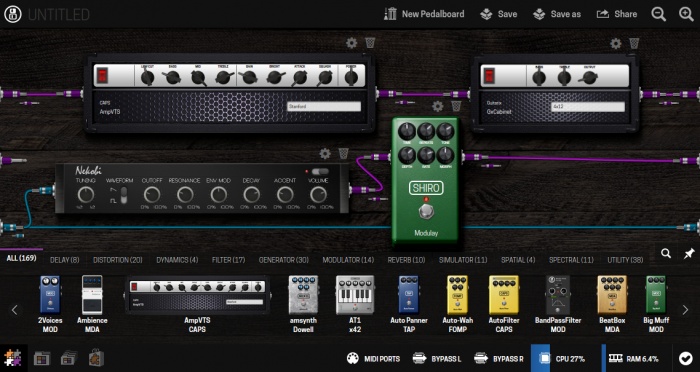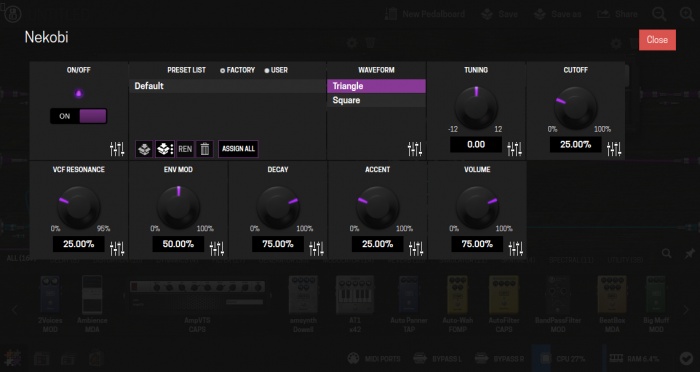Difference between revisions of "MOD Web GUI User Guide"
Jesseverhage (talk | contribs) |
Jesseverhage (talk | contribs) |
||
| Line 44: | Line 44: | ||
==Adding/removing plugins to/from your pedalboard== | ==Adding/removing plugins to/from your pedalboard== | ||
| − | ==Making connections== | + | Adding a new plugin to your pedalboard is very intuitive, simply select a plugin from the bar in the bottom of the screen, then drag and drop it onto the wooden background and connect it. The canvas will automatically resize when you drag a plugin to the edge of the display. |
| + | |||
| + | To remove a plugin, simply press the garbage bin icon in the upper right-hand side of the plugin. This will also remove the connections to that plugin. | ||
| + | |||
| + | ==Making/removing connections== | ||
| + | The MOD Duo has different types of cables that can be connected to different ports: | ||
| + | *Purple for audio | ||
| + | *Blue for MIDI | ||
| + | *Orange for CV | ||
| + | |||
| + | Connections can be made starting from signal sources (your inputs on the left or the outputs of plugins) to signal inputs (your outputs on the right, or the inputs of plugins) | ||
| + | |||
| + | Click, hold and drag the plug to the desired input port, and a connection is made. | ||
| + | |||
| + | You will notice that even after a connection has been made, you can still make more connections from the same output. The same goes for the inputs, you can connect as many outputs as you want, to a single input. Experiment and come up with the craziest ideas! | ||
| + | |||
| + | To remove a connection: click, hold and drag the plug away from the input, the connection will disappear immediately. | ||
| + | |||
==Accessing plugin configuration screen== | ==Accessing plugin configuration screen== | ||
| + | In case you want to tweak the different parameters that are not directly shown in the interface, create presets for the plugin or set up physical controls for changing parameters (actuator mapping), you need to access the plugin configuration screen. | ||
| + | |||
| + | Simply press the gear icon in the upper right-hand side of the plugin to enter the configuration screen. | ||
| + | |||
| + | [[File:Webinterface_pluginconfig.jpg|thumb|none|700px|The plugin configuration screen]] | ||
| + | |||
===Setting up actuator mapping=== | ===Setting up actuator mapping=== | ||
| + | TODO: explain routine, etc | ||
| + | |||
===Setting up and using plugin presets=== | ===Setting up and using plugin presets=== | ||
| + | TODO: explain routine, etc | ||
| + | |||
==Saving your pedalboard== | ==Saving your pedalboard== | ||
| + | TODO: explain routine, etc | ||
| + | |||
==Sharing your pedalboard== | ==Sharing your pedalboard== | ||
| + | TODO: explain routine, etc | ||
| + | |||
==Auto update== | ==Auto update== | ||
| + | When an update becomes available for the MOD Duo, a message pops up from the icon in the bottom-right of the screen, prompting you to update your device. Simply press the "Get update" text, and the process will start. | ||
=Pedalboard library= | =Pedalboard library= | ||
Revision as of 15:48, 7 November 2016
This chapter describes the graphical user interface (GUI) that is used for installing and removing plugins, setting up your pedalboards and banks, sharing pedalboards and more.
TODO: add images of GUI
Contents
Accessing the GUI
In order to access the GUI, the MOD Duo needs to be hooked up to your device(*), either through USB or through Bluetooth.
Follow the steps below to access the GUI.
(*) the device can be anything that has access to a web browser, and has a USB host port, or Bluetooth connectivity. We recommend using a PC or laptop, because the interface is not yet optimized for smaller screen sizes.
USB
- Power up the MOD Duo
- Connect the USB-B port of the MOD Duo to a USB port on your device
- Open your favorite browser, and navigate to 192.168.51.1
Bluetooth
- Power up the MOD Duo
- Make the Bluetooth connection
- Open your favorite browser, and navigate to 192.168.50.1
Bottom bar
The bar at the bottom of the web interface allows you to:
- Navigate to different sections of the web interface: use the buttons on the left
- From left to right: pedalboard builder, pedalboard library, banks, plugin store
- Add/remove MIDI devices: click the "MIDI PORTS" button
- Bypass the effects chain for each individual input: click the bypass buttons
- Monitor the CPU and RAM usage
- Keep your MOD Duo up to date: hover over the rightmost button
Pedalboard builder
Inputs and outputs
The inputs can be found on the left side of the interface, the outputs can be found on the right side of the interface. The signal flow goes from left to right.
The top two inputs are the physical audio inputs on your device. The other(*) inputs on the left side are the MIDI devices that you have added, together with the DIN-MIDI in port that is always shown.
Likewise, the top two outputs are the physical audio outputs of your device. The other(*) outputs on the right side are the MIDI devices that you have added, together with the DIN-MIDI out port that is always shown.
(*) hover over the input/output to see to which MIDI device it belongs.
Adding/removing plugins to/from your pedalboard
Adding a new plugin to your pedalboard is very intuitive, simply select a plugin from the bar in the bottom of the screen, then drag and drop it onto the wooden background and connect it. The canvas will automatically resize when you drag a plugin to the edge of the display.
To remove a plugin, simply press the garbage bin icon in the upper right-hand side of the plugin. This will also remove the connections to that plugin.
Making/removing connections
The MOD Duo has different types of cables that can be connected to different ports:
- Purple for audio
- Blue for MIDI
- Orange for CV
Connections can be made starting from signal sources (your inputs on the left or the outputs of plugins) to signal inputs (your outputs on the right, or the inputs of plugins)
Click, hold and drag the plug to the desired input port, and a connection is made.
You will notice that even after a connection has been made, you can still make more connections from the same output. The same goes for the inputs, you can connect as many outputs as you want, to a single input. Experiment and come up with the craziest ideas!
To remove a connection: click, hold and drag the plug away from the input, the connection will disappear immediately.
Accessing plugin configuration screen
In case you want to tweak the different parameters that are not directly shown in the interface, create presets for the plugin or set up physical controls for changing parameters (actuator mapping), you need to access the plugin configuration screen.
Simply press the gear icon in the upper right-hand side of the plugin to enter the configuration screen.
Setting up actuator mapping
TODO: explain routine, etc
Setting up and using plugin presets
TODO: explain routine, etc
Saving your pedalboard
TODO: explain routine, etc
Sharing your pedalboard
TODO: explain routine, etc
Auto update
When an update becomes available for the MOD Duo, a message pops up from the icon in the bottom-right of the screen, prompting you to update your device. Simply press the "Get update" text, and the process will start.

